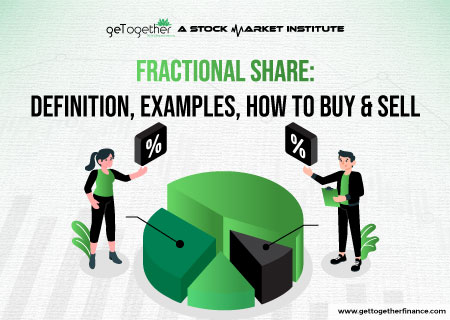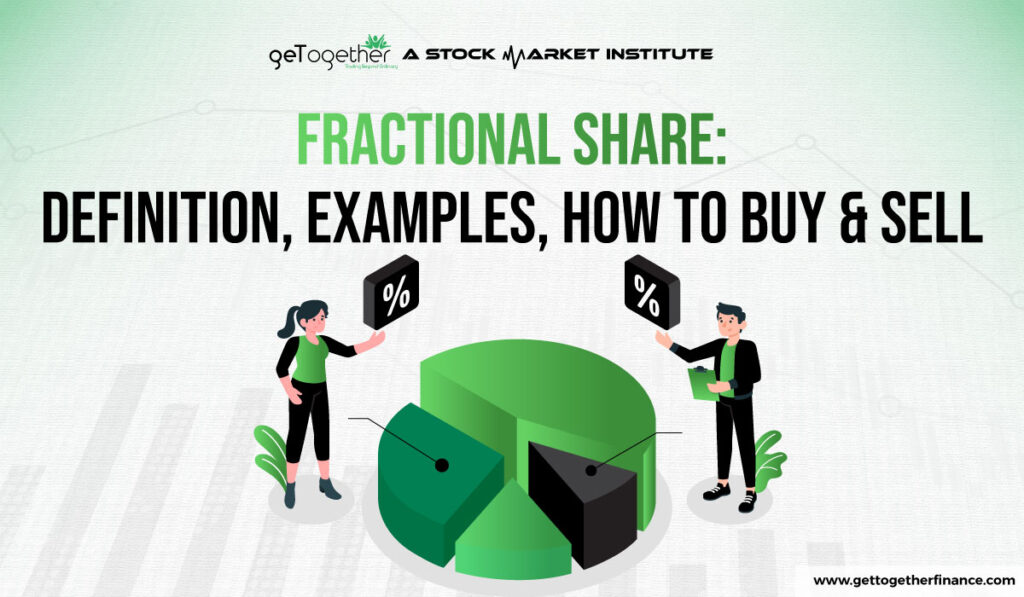Fractional Share: Definition, Examples, How To Buy & Sell


Overview
Have you ever wanted to invest in a company like Apple or Tesla, but the stock price seemed a bit out of reach? The idea of fractional shares has been around for a while but is gaining popularity, especially after the introduction of in-app and online platforms.
Traditionally, when you buy a stock, you buy a whole share. This could be expensive, especially for companies with high stock prices. But this allows you to invest in a portion of a share. It offers an opportunity to investors who are looking forward to diversifying their portfolio across multiple asset and asset class options, without needing to invest a huge amount of money upfront. But what are fractional shares, how do they work, and how can one buy and sell?
Let’s explore the concept with a more in-depth view.
Want to start your Investment Journey?

In reality, starting the investment journey does not have to be as intimidating as it sounds. Whether you are a beginner or you have some experience, it is only about taking that leap. It may interest you that you do not need a lot of funds to get started. If you develop a solid plan, you can start off small and build your financial portfolio over time.
Investing is a way of making more money in the long run and it is always much better than just saving in the banks. If you know the tips and tricks to it and keep doing it actively, then financial growth is in your category. You can begin with a bare minimum amount of RS 500 in SIP or mutual funds to go beyond and above as per your understanding of the market.
What Are Fractional Shares

A fractional share is a part of a stock that is less than a whole share. This lets you buy a piece of expensive stocks like Apple or Tesla without needing to buy a full share. You can invest in pricey stocks with less money.
Fractional shares make it easier to enter the stock market. You can buy shares with the amount of money you have, not just full shares. This way, even with limited funds, you can own parts of high-priced stocks and invest in big companies.
Understanding a Fractional Share

Fractional shares are less than a whole share and can come about in several ways, including dividend reinvestment plans, stock splits, and mergers.
Mergers and Acquisitions
Mergers and acquisitions (M&As) can also create a fractional share as companies combine stocks using a set ratio. This often results in fractional shares for shareholders.
Stock Splits
Stock splits can create a fractional share when the stock split doesn’t result in whole numbers. For example, in a 3-for-2 stock split, an investor with an odd number of shares would end up with fractional shares. Three shares would become 4.5, five would become 7.5, and so on.
Dividend Reinvestment Plans
Dividend reinvestment plans (DRIPs) often create fractional shares. In a DRIP (Dividend Reinvestment Plans), a company or brokerage lets investors use dividend payouts to buy more shares, even if it’s not a whole share. Reinvesting capital gains and rupee-cost averaging programs can also lead to this.
Some brokerage firms intentionally split whole shares to sell a fractional share to clients, especially for high-priced stocks like Tesla (TSLA) or Berkshire Hathaway (BRK.A). As of March 2020, TSLA was over ₹1,30,000 per share and BRK.A was over ₹2,50,000 per share. It can be the only way individual investors can buy stock in such companies.
Benefits of Fractional Shares

Overall, a fractional share can democratise investing by making it more accessible, flexible, and potentially less risky for a wider range of investors. Here is a list of benefits that an investor can reap by leaping for this investment:
- Lower Entry Barrier: It allows you to invest in expensive stocks without needing a large amount of money. You can buy a part of a high-value stock, making it more accessible.
- Diversification: With this, you can spread your investment across different stocks, reducing risk. This means you can own a variety of stocks even with a small budget.
- Flexibility: You can invest whatever amount you have, no matter how small. This makes it easy to start investing without waiting to save up for a full share.
- Reinvestment: It allows for easy reinvestment of dividends. Instead of receiving small cash dividends, you can use them to buy more shares, even if it’s less than one full share.
- Accessibility: It opens up opportunities to invest in high-priced stocks that might otherwise be out of reach. This inclusivity can attract more people to the stock market.
- Cost Averaging: With this, you can practise dollar-cost averaging, buying shares at different prices over time, which can help mitigate market volatility.
Limitations of Fractional Shares

With benefits come disadvantages. Here are the setbacks of investing in fractional shares:
- Limited Availability: Not all brokerage firms offer trading these shares, which can limit your investment options.
- Low Liquidity: These might be harder to sell quickly since there might not be a high demand for them, affecting your ability to cash out.
- Fees: Some brokers charge fees for buying and selling fractional shares. These fees can add up, especially with smaller investments, reducing your overall returns.
- No Shareholder Rights: With these, you might not get the same voting rights as full shareholders, which means less influence over company decisions.
- Complexity: Managing these shares can be more complicated than dealing with whole shares, especially when tracking your investments and calculating returns.
- Dividends: Dividend payments on these shares might be rounded down, potentially reducing your income slightly compared to owning full shares.
- Transferability: Transferring these shares between brokerage accounts can be difficult or impossible, limiting your flexibility to switch brokers.
How to Buy And Sell Fractional Shares

Investing in fractional shares is a piece of cake and can be done as easily as buying a normal share. Here is the process of buying and selling these shares:
Buying Fractional Shares
- Choose a Platform: Start by exploring various online brokerage platforms, investing apps, or robo-advisors. These platforms let you buy portions of stocks or ETFs, making investing accessible even with a small budget.
- Check Availability: Not all stocks or ETFs may be available as fractional shares. Ensure the platform you choose offers these shares for the assets you’re interested in.
- Compare Options: Look at different platforms to find the best fit for your needs. Consider factors like minimum investment requirements, available assets, and user interface.
- Open an Account: Once you’ve chosen a platform, open an account. This usually involves providing some personal information and linking a bank account for funding.
- Fund Your Account: Deposit money into your account. The amount can be as small as the platform’s minimum investment requirement.
- Select Your Investment: Choose the stock or ETF you want to invest in. Enter the amount you want to invest rather than the number of shares.
- Review and Confirm: Before purchasing, review the details of your investment, including any potential commissions or fees. Confirm your purchase to complete the transaction.
Also Read: Preference Shares
Selling Fractional Shares
- Log In to Your Account: Access your investment platform and navigate to your portfolio.
- Select the Fractional Shares: Choose the shares you want to sell.
- Enter the Amount to Sell: Specify the amount you wish to sell. You can usually sell in terms of currency value or a portion of your shares.
- Review and Confirm: Check the details of your sale, including the amount and any fees or commissions. Confirm to complete the transaction.
- Withdraw Funds: After selling, you can withdraw the funds to your linked bank account.
While fractional share trading for Indian stocks isn’t available yet (as of June 17, 2024), there are some platforms that offer fractional share trading for US stocks for Indian investors such as Stockal, Stash, Charles Schwab, etc.
Fractional Shares in India

Fractional share ownership in India could face a delay. While the Securities and Exchange Board of India (SEBI) is keen on the concept, as highlighted by SEBI Chairperson Madhabi Puri Buch last year, changes to the SEBI Act and Companies Act are needed for approval. This delay is despite the potential to make the stock market more accessible.
Fractional shares would allow people to buy portions of expensive stocks, like owning a fraction of a ₹110,000 MRF share instead of needing the entire amount. This concept is already familiar in the US, where investors can buy parts of companies like Apple. It can be a revolutionary action for the Indian stock market, but it will require specific regulations and changes in the Company Act and SEBI act. As SEBi started till now it remains as non-tradable instruments in India, however, once the regulations are altered and formed, it can allow investors a pool of investment opportunities.
Conclusion
Fractional shares are an investment opportunity for those who don’t want to or own a big chunk of money to invest. However, it can be a potential game-changer for the Indian stock market, offering increased accessibility, flexibility, and diversification for investors. While regulations haven’t yet been finalized, there’s growing interest from both investors and brokerages. Keeping an eye on SEBI announcements and financial news can help you stay updated on the latest developments.
FAQs
Are fractional shares good for beginners?
Yes, these shares can be a good option for beginners. They allow you to start investing with smaller amounts and potentially reduce risk by diversifying your portfolio.
Can I trade fractional shares of US stocks from India?
Yes, some platforms like Stockal allow Indian investors to trade these shares of US stocks.
When will fractional share trading be available in India?
The exact date is yet to be determined. Regulations for fractional shares in India are still under discussion by SEBI (Securities and Exchange Board of India).
What are the risks of fractional shares?
While these shares seem beneficial, there are also some potential risks to consider:
Fees: It might have different fee structures compared to whole share trading.
Limited Liquidity: It might have lower trading volume than whole shares, making it slightly harder to buy or sell them quickly.
How can fractional shares impact the Indian stock market?
The potential impact is positive. These shares could increase investor participation and liquidity in the market.



 Facebook
Facebook  Instagram
Instagram  Youtube
Youtube 
